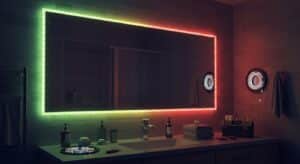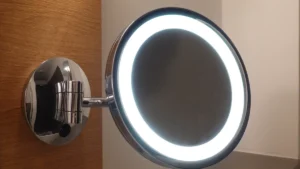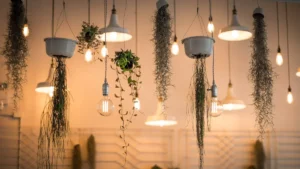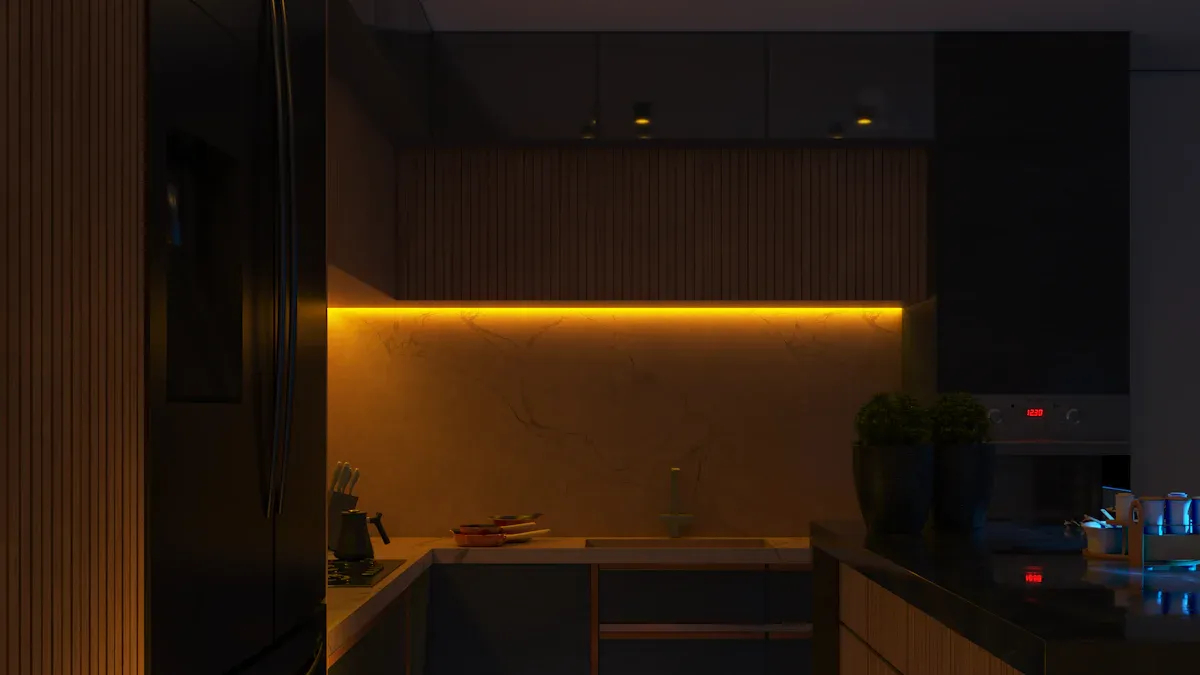
Hiding LED strip lights makes cabinets and shelves look modern. Visible strips can cause harsh light, ruining the cosy feel. Placing them out of sight spreads light softly and looks better. It also keeps the strips safe from dust and damage, lasting longer. Some people struggle with glare or messy wires, but channels with covers help fix this. Installing them properly makes them work better and keeps them safe, lowering risks from exposed lights.
Key Takeaways
Hiding LED strip lights makes cabinets and shelves look better. It gives them a modern and cool style.
Channels and diffusers help soften the light. They spread it evenly, making rooms cosy and welcoming.
Installing LED strips properly keeps them safe from dust and harm. This helps them last longer and saves money on new ones.
Planning and measuring carefully ensures LED strips fit well. This makes the lighting look tidy and work properly.
Fun hiding ideas, like using plant pots or built-in lights, add creative designs while still being useful.
Benefits of Hiding LED Strip Lights
Better Appearance
Hiding LED strip lights makes cabinets and shelves look stylish. Covered lights remove the messy look of visible strips. This gives a neat and modern design. A 2023 HomeAdvisor study showed people spend about £2,300 on lighting upgrades. Hidden and built-in lights are a popular choice. This shows many prefer designs that mix usefulness with beauty.
Hidden LED strips can also be used for mood or display lighting. You can show off decorations or create a cosy feel. The hidden lights give a soft glow that looks elegant and welcoming.
Less Glare and Softer Light
Exposed LED strips can be too bright and glaring. Hiding them fixes this by spreading the light evenly. This makes the light softer and more comfortable for your eyes. It also improves the room’s overall feel.
Feature | Benefit |
|---|---|
Less Glare and Reflection | Hidden strips stop harsh glare, even in shiny spaces. |
Better Light Spread | Covered strips give softer, evenly spread light. |
By hiding LED strips, you get useful light without it being too strong. This works well in kitchens, bedrooms, and living rooms. These are spaces where comfort and function both matter.
Protection and Longer Life
Hiding LED strips not only looks good but keeps them safe. Exposed strips can get dusty, wet, or damaged easily. Putting them in channels or recesses protects them from harm. This keeps them working well for a longer time.
Good installation also protects the wires and sticky backing. This means you won’t need to fix or replace them often. It saves you money and effort. Protecting your LED strips helps them stay bright and last longer, giving you better value.
Planning for Installing and Hiding LED Strip Lights
Assessing Cabinets and Shelves
Before installing LED strip lights, check your cabinets and shelves carefully. Measure the areas to make sure the strips fit well. Use a tape measure to find the length and width of the space. This helps you buy the right size of LED strip lights and avoid wasting materials.
Think about where to place the lights for the best look and use. For example, under-cabinet lights are great for kitchen tasks. Shelf lights can make decorations stand out. Look at the space closely to pick the best spots for the strips. Good planning makes the lights look neat and work well.
Choosing Materials for Hiding LED Strip Lights
Picking the right materials is important for hiding LED strip lights. LED channels with covers are popular because they hide the strips and soften the light. Cove moulding works well for shelves, blending with the furniture and keeping the strips hidden.
Choose strong materials that match your LED strips and can handle heat. Make sure they allow air to flow around the lights. Good materials make the lights look better and protect them, helping them last longer.
Key Consideration | Description |
|---|---|
Careful Planning | Measure spaces properly to get the right strip lengths. |
Power Needs | Check the total power needed for your LED strips. |
Controller Match | Ensure the controller works with your type of LED strips. |
Tools Needed for Installation
Using the right tools makes installing LED strip lights easier and neater. You’ll need:
Measuring Tape: To measure the space accurately.
Utility Knife: To cut the strips to the correct size.
Wire Strippers: For fixing wires if needed.
Electrical Tape: To secure wires safely.
Adhesive or Clips: To hold the strips in place.
For harder jobs, tools like a saw (for cutting moulding), a stud finder (to find strong spots for mounting), and cable clamps (to tidy wires) might be needed. Using the right tools gives a clean finish and avoids mistakes.
Tip: Check the voltage of your LED strips and power supply to prevent damage. Keep the power supply in a cool place with good airflow.
Methods to Hide LED Strip Lights
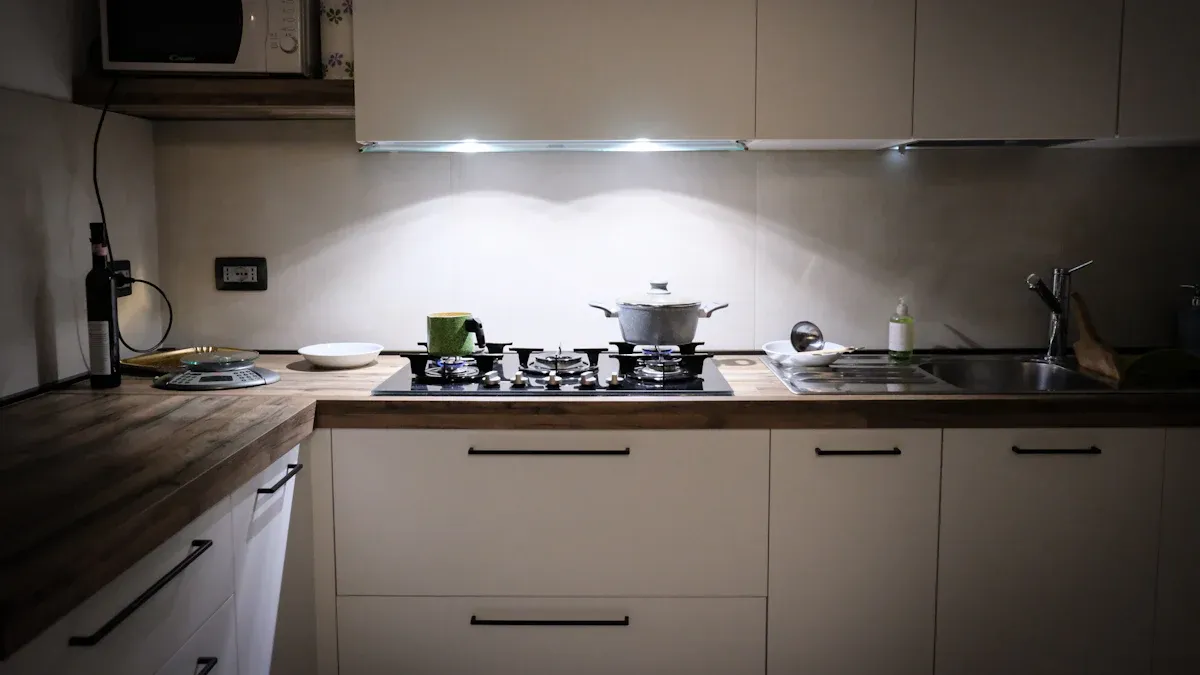
Using LED Channels and Diffusers
LED channels and diffusers are great for hiding LED strip lights. These aluminium holders hide the strips and make them work better. Diffusers spread the light evenly, making it softer and less harsh. They also protect the strips from dust and damage, helping them last longer.
You can place LED channels under cabinets or on shelves for a neat look. They match the furniture and add both style and function. Frosted diffusers are helpful as they soften the light and hide the LED dots. This method works well in kitchens, living rooms, and display areas where looks matter.
Tip: Use good-quality aluminium channels. They handle heat better and last longer, keeping your LED strip lights efficient.
Recessed Lighting for Cabinets and Shelves
Recessed lighting is a modern way to hide LED strip lights. It involves placing the strips inside cabinets or shelves for a smooth finish. This keeps the light source hidden while giving bright and useful light.
To do this, you can use wood or drywall to create spaces for the strips. This method is great for under cabinets, offering light for tasks without making the design messy. Plan carefully to ensure the strips are placed at the right depth for even light.
Recessed lighting makes cabinets and shelves look better and work well. It removes dark spots and highlights areas, making it easier to organise and display items.
Creative Ways to Hide LED Light Strips
There are fun ways to hide LED strip lights if you want something unique. For example, use planters with hanging leaves to cover the strips while adding greenery. Another idea is to use wood panels to hide the strips, creating a warm and cosy feel with soft light.
Cornices and valances are also good for hiding strips. They let the light shine softly without showing the source. You can also place strips behind mirrors or TVs to make the room feel more stylish. For a modern touch, put strips at the bottom or sides of a room for a floating effect.
These creative ideas not only make your space look better but also give you many design options. Trying these methods can help you create a unique and professional lighting setup.
Concealing Wiring and Power Supplies
Hiding Wires Along Edges or Panels
Hiding wires neatly makes your LED strip lights look better. A simple way is to run wires along cabinet or shelf edges. Use sticky wire clips to hold the wires in place. These clips are easy to use and stop wires from hanging loosely.
You can also use plastic covers or wooden trays to hide wires. These materials fully cover the wires and match your furniture. In kitchens, wires are often hidden under shelves or behind furniture. This keeps them out of sight but still easy to reach if needed.
Drop ceilings are another great option for hiding wires. Place the wires above the ceiling for a smooth and tidy look. This method works well in modern-style rooms.
Method | Description |
|---|---|
Sticky Wire Clips | Hold wires neatly along edges for a clean look. |
Plastic Covers/Wooden Trays | Fully hide wires, blending with furniture design. |
Drop Ceilings | Place wires above ceilings for a seamless and neat appearance. |
Tip: Avoid bending wires too tightly. This can damage them and cause problems.
Managing Power Supplies for a Clean Look
Hiding the power supply is as important as hiding wires. Place it in a hidden spot like inside a cabinet or behind furniture. This keeps it out of view but easy to access for maintenance.
Wire channels are useful for hiding power supplies and wires. They make the setup look professional and organised. You can also use cable sleeves to group wires together, reducing mess and keeping things tidy.
For under-cabinet lighting, put the power supply underneath the cabinet. This keeps it close to the lights but hidden from sight. Make sure it has enough airflow to stay cool and avoid overheating.
Unordered list of extra tips:
Use wire covers that match the colour of your furniture.
Hide wires under shelves or furniture for a cleaner look.
Keep the power supply in a cool, airy spot to prevent heat issues.
By using these ideas, you can create a neat and organised setup. This improves the look of your LED strip light installation.
Tips and Safety for Hiding LED Strip Lights
Easy Ways to Hide LED Strips
To make your LED strips look neat, try these ideas. Aluminium channels are a great choice. They hide the strips and help them stay cool. This makes the lights last longer. For under-cabinet lighting, these channels spread light evenly. They work well in kitchens and work areas.
Another option is recessed lighting. You can place LED strips inside shelves or walls. This gives a smooth and modern look. It’s perfect for cove lighting or showing off special features in a room. For a creative twist, hide strips behind furniture, pictures, or mirrors. This creates soft, indirect light that makes the room feel cosy.
Use diffusers for a softer glow and to hide LED dots. Place strips behind edges or lips on walls or ceilings. This reduces bright spots and spreads light evenly. Always stick the strips firmly so they don’t come loose later.
Tip: Keep LED strips away from flammable items and stuffy spaces. This stops overheating and keeps them safe to use.
Staying Safe While Installing
Safety is very important when setting up LED strips. Pick strips with safety labels like UL-listed ones. These meet the right standards. Follow the instructions carefully, especially when cutting or joining strips. Always unplug the lights before making changes.
Use the right wires and connectors to avoid electrical problems. If the strips are in closed spaces, make sure there’s airflow to stop overheating. Aluminium heat sinks can also help keep the strips cool.
Choose safe spots for your strips. Keep them away from flammable things and sharp bends. Clean the surface well before sticking the strips down. This helps them stay in place. To hide wires, use covers or sleeves. This keeps the area tidy and prevents tripping.
Note: Check your LED strips often for damage or wear. Replace broken parts quickly to keep them safe and working well.
Hiding LED strip lights has many benefits. It reduces glare and makes your space look better. Hidden lights give a clean and stylish finish. They also protect the strips, helping them last longer. Planning well is key for a smooth setup. Measure your spaces carefully, pick strong materials, and use helpful tools.
For a neat result, try aluminium channels or recessed lighting. These options hide the strips and spread light evenly. Always focus on safety by allowing airflow and using good-quality parts. With good planning, you can make your cabinets and shelves both useful and attractive.
Pro Tip: Hidden lights can show off art or decorations, making them stand out.
FAQ
What’s the easiest way to hide LED strip lights?
Use aluminium channels with diffusers for the best results. These hide the strips, soften the light, and protect them from dust. They also give a neat and professional look.
Can I cut LED strip lights to fit shelves or cabinets?
Yes, you can cut LED strips at marked spots. These marks show where it’s safe to cut. Use scissors or a utility knife, and turn off the power first. Always check the instructions from the manufacturer.
How can I stop LED strip lights from overheating?
Make sure air can flow around the strips. Aluminium channels help spread heat and keep them cool. Don’t put strips in closed spaces without ventilation. Keep the power supply in a cool, airy place to avoid overheating.
Are LED strip lights safe for wooden furniture?
Yes, they are safe if installed properly. Use aluminium channels to stop heat build-up. Attach the strips securely and keep them away from flammable items.
How do I hide wires for a tidy look?
Run wires along edges or behind panels using sticky clips. You can also use plastic covers or cable sleeves to group wires neatly. Place the power supply in a hidden but easy-to-reach spot, like inside a cabinet or behind furniture.
See Also
Enhance Your Kitchen Cabinets With LED Strip Lighting
Effective Installation Tips For RGB LED Strip Lights
Best Practices For Installing LED Strip Lights In 2025

